This post was most recently updated on May 9th, 2024
How’s your experience been with invalid traffic (IVT)? If left unchecked, fake traffic can cause publishers to lose their ad accounts and experience many unpleasant issues in their business.
Did you know that over 40% of all traffic online is invalid? Invalid traffic is any activity that is generated by bots, click farms, or other forms of fraudulent activity that are designed to inflate website traffic artificially. Click Farms or media buyers who purchase bots often bolster this type of activity to create a false sense of engagement via inflated ad clicks or to manipulate website analytics. Unfortunately, this trend is on the rise, and it’s significantly impacting the AdTech industry.
According to the latest industry reports:
- The cost of digital ad spend wasted on fake traffic is projected to reach $50 billion globally in 2024.
- Sophisticated IVT threats, such as advanced bots, click hijacking, and data center traffic, have become more prevalent, accounting for a larger share of the overall IVT problem.
The Cost of Fake Traffic
The impact of invalid traffic (IVT) on the cost of digital advertising has only worsened in 2024. In 2024, it is estimated that advertisers will waste over $71 billion on fake or invalid traffic, which is a 33% increase from the $36 billion wasted in 2022.
This staggering $71 billion in wasted ad spend is a significant problem for the digital marketing industry, and it’s clear that more needs to be done to combat the growing threat of invalid traffic.
The issue of fake traffic is pervasive across various digital advertising channels, with platforms like LinkedIn, Meta, Bing, X (formerly Twitter), and Pinterest having particularly high invalid traffic rates.
Even Google’s platforms, which have a lower fake traffic rate of 5.5%, still account for a substantial $16.6 billion in wasted ad spend.
In total, the combined wasted ad spend on fake traffic across Google and non-Google platforms is projected to reach a massive $71 billion in 2024, highlighting the urgent need for the digital marketing industry to address this challenge.
Invalid Traffic vs. Site Traffic
Invalid traffic doesn’t just impact advertising costs. It can also skew website traffic statistics, making it difficult for website owners and marketers to accurately measure engagement and traffic sources. Last year, it was estimated that invalid traffic amounted to approximately 8% of all site traffic. Of this 8%, paid ads contributed 4.9%, direct traffic contributed 7.5%, and organic traffic contributed 5.7%. These statistics highlight the need for website owners and marketers to take action to combat invalid traffic and ensure that their analytics accurately reflect real user engagement.
Fake Traffic Breakdown
| Threat Type | Percentage of Total Fake Traffic |
|---|---|
| Automation Tools | 20.1% |
| Click Hijacking | 16.6% |
| Disabled JS | 13.6% |
| VPN | 13.6% |
| Scraper | 9.1% |
| Data Centers | 9.0% |
| Malicious Bots | 8.1% |
| False Representation | 3.6% |
| Proxy | 1.8% |
Let’s get deeper into these threat types:
- Automation Tools: These software programs automate tasks like filling out forms or clicking links. They accounted for 20.1% of all fake traffic online.
- Click Hijacking: This is a fraudulent activity where a user’s click is redirected to a different website or advertisement without their knowledge or consent. Click hijacking grew by 125% in 2022, accounting for 16.6% of invalid traffic.
- Disabled JS: This refers to the disabling of JavaScript, which can prevent tracking and ad-blocking. It accounted for 13.6% of all IVT.
- VPN: A virtual private network masks a user’s IP address and location. Last year, VPNs accounted for 13.6% of all fake traffic.
- Scraper: Scrapers are automated programs that extract data from websites. They accounted for 9.1% of all fake traffic.
- Data Centers: These facilities store and manage large amounts of data. They accounted for 9.0% of all IVT.
- Malicious Bots: These are software programs designed to carry out harmful activities, such as stealing data or causing damage to a system. They accounted for 8.1% of all invalid traffic last year.
- False Representation: Refers to fraudulent advertising or marketing that misrepresents a product or service. It accounted for 3.6% of all fake traffic in 2022.
- Proxy: A proxy server is an intermediary between a user and the internet. Proxies accounted for 1.8% of invalid traffic.
Fake traffic rates by referral sources
| Referral Source | Fake Traffic Rate |
|---|---|
| Direct | 22.1% |
| Paid Streaming | 11.1% |
| Display | 7.2% |
| Organic | 6.2% |
| Paid Social | 5.6% |
| Paid Search | 5.5% |
| Organic Search | 5.4% |
| Organic Streaming | 5.0% |
To optimize your website’s traffic, it’s important to regularly monitor your referral sources and take action to address any fake traffic.
The table above shows that direct referrals had the highest fake traffic rate at 22.1%, followed by paid streaming at 11.1% and display at 7.2%. Organic referrals had a slightly lower fake traffic rate at 6.2%, while paid social, paid search, and organic search all had rates between 5.0% and 5.6%.
Publishers need to take this data seriously to ensure that their traffic is legitimate and accurately reflects user engagement. By understanding which referral sources have higher rates of fake traffic, they can take steps to detect and prevent invalid traffic, improving their website’s analytics and overall performance.
IVT by Industry
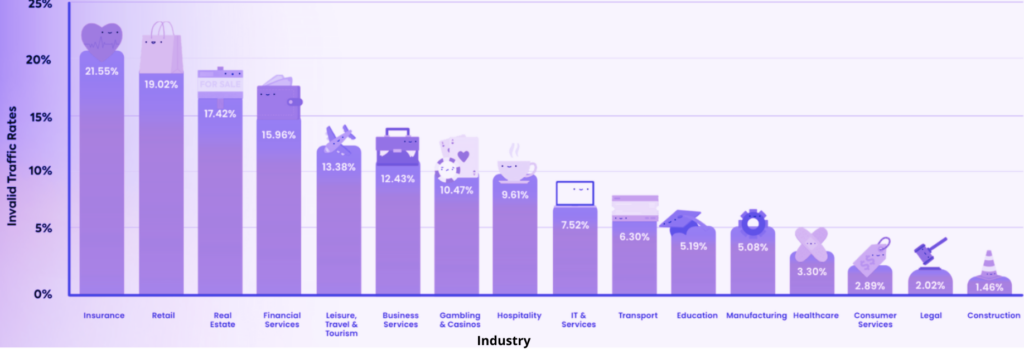
Invalid traffic is a pervasive problem that affects all businesses investing in digital advertising. However, our analysis of click data from clients across a range of sectors shows that average invalid traffic rates vary significantly by industry.
Insurance (21.55%)
The insurance industry experiences a high invalid traffic rate. Bots engage in quote manipulation, generate fake policy applications, and attempt to exploit insurance-related ad campaigns.
Retail (19.02%)
The retail industry experiences a high invalid traffic rate. Bots mimic genuine interest in products to skew vanity metrics, engage in ad fraud and manipulate inventory through bulk fake checkouts.
Real Estate (17.42%)
The real estate sector faces a significant invalid traffic rate. Bots manipulate property listings, generate fake inquiries, and exploit real estate-related ad campaigns.
Financial Services (15.96%)
The financial services industry faces a significant invalid traffic rate. This is attributed to bots attempting to manipulate financial markets, exploit online banking vulnerabilities or investment platforms, and engage in phishing scams targeting users’ financial information. The financial services industry also has a significantly higher CPC compared to the market, making it a lucrative target for ad fraudsters.
Leisure, Travel & Tourism (13.38%)
The leisure and travel sector contends with a notable invalid traffic rate. Bots manipulate travel bookings, exploit promotional deals, and engage in click fraud targeting travel-related ads.
Impact on Small and Medium-Sized Businesses
Small and medium-sized businesses face unique challenges when it comes to combating fake traffic. The presence of IVT can disproportionately affect these companies in several ways:
- Financial Losses: SMBs often operate on tighter budgets compared to larger corporations. The financial impact of wasted ad spend on fake traffic can be particularly damaging for SMBs, leading to a significant loss of resources that could have been allocated to more productive marketing efforts. In 2024, SMBs are estimated to lose an average of 25% of their digital advertising budget to fake traffic.
- Resource Drain: Fake traffic not only wastes advertising dollars but also consumes valuable resources within SMBs. The time and effort spent on managing campaigns affected by IVT, dealing with fake leads, and cleaning up databases can divert attention from core business activities and growth initiatives. On average, SMBs spend 15-20% of their marketing team’s time addressing issues related to fake traffic.
- Data Integrity: The presence of fake traffic can compromise the accuracy and reliability of data used by SMBs to make critical business decisions. Inaccurate analytics, skewed performance metrics, and polluted databases can hinder SMBs’ ability to assess the effectiveness of their marketing strategies and make informed decisions. Approximately 30% of SMBs report data inaccuracies and inconsistencies due to fake traffic.
- Security Risks: Malicious bots and fake users can pose security threats to SMBs, compromising data integrity, user privacy, and overall website security. The infiltration of fake traffic can expose vulnerabilities in SMBs’ online systems and lead to potential data breaches or cyberattacks. SMBs face an average of 10 cybersecurity incidents per year related to fake traffic.
- Operational Efficiency: IVT can disrupt the operational efficiency of SMBs by creating inefficiencies in marketing campaigns, sales processes, and customer interactions. The presence of fake leads, invalid inquiries, and fraudulent activities can hinder the smooth functioning of SMB operations and impact overall productivity. SMBs report a 20% decrease in operational efficiency due to the impact of fake traffic.
The top 10 countries based on IVT to traffic ratio
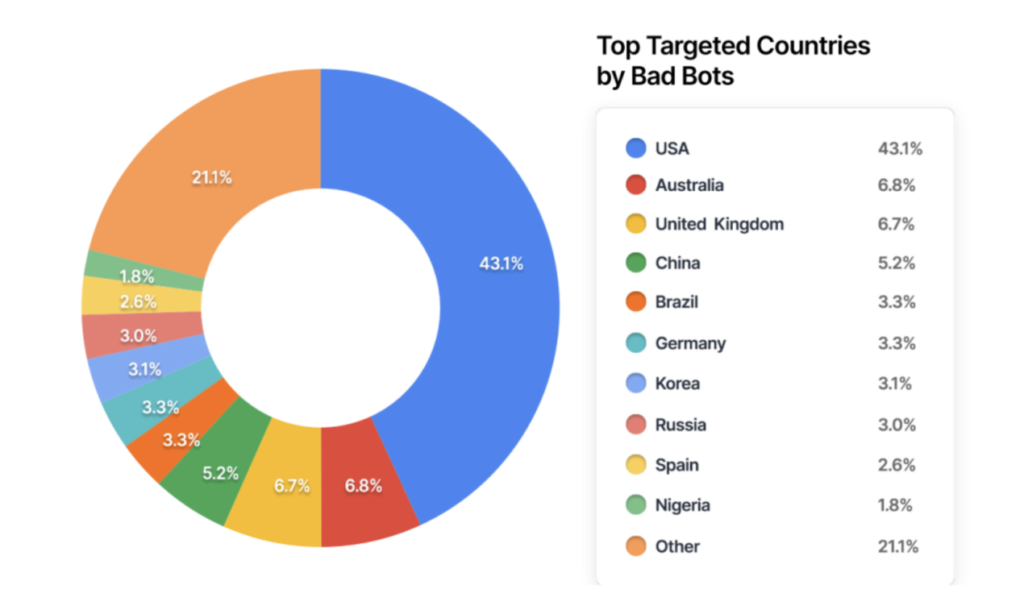
This graph demonstrates the percentage of traffic per country that turned out to be invalid traffic. As you can see, the USA had the highest rate of invalid traffic at 44%, with Australia in second place at 6.8% and Nigeria at the lowest at 1.8%.
IVT to traffic ratio by device category
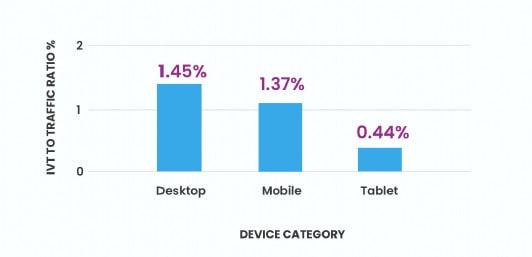
Out of the 1.95 billion page views we analyzed, 1.45% of the desktop traffic was detected as invalid traffic. Mobile came in second with 1.37%, and tablet devices last at 0.44%.
Top 10 browsers used for driving invalid traffic
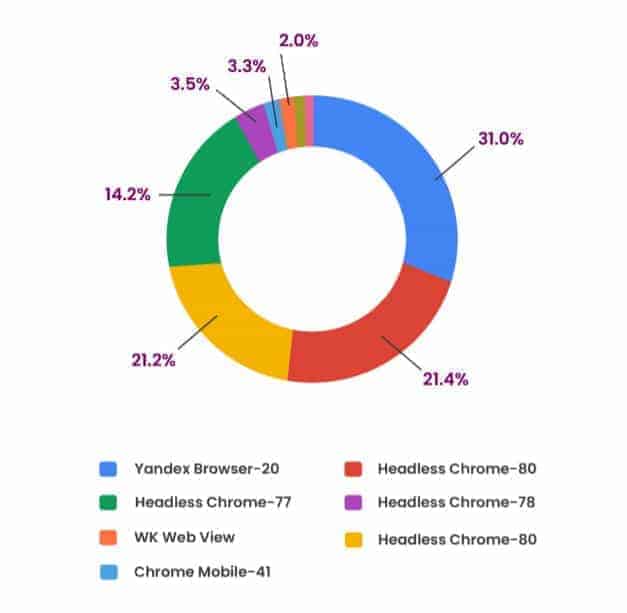
In this section, the browser is determined by the user agent. As you can see, the Yandex browser-20 leads invalid traffic with 31%, followed by a variety of different Google Chrome versions.
Mac OS vs Windows OS based on IVT to traffic ratio
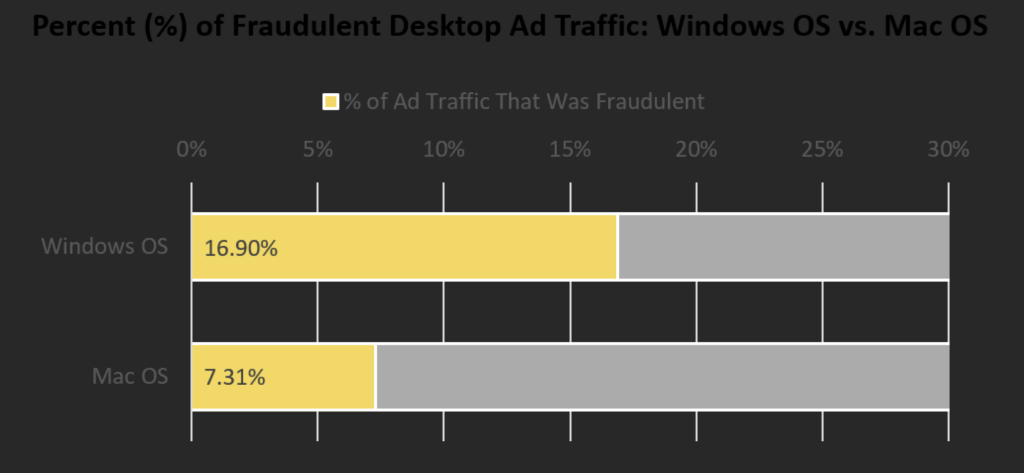
This graph shows that 17% of ad traffic from Windows OS was fraudulent compared to Mac OS’s 7.31%.
IVT to traffic ratio by popular UTM source
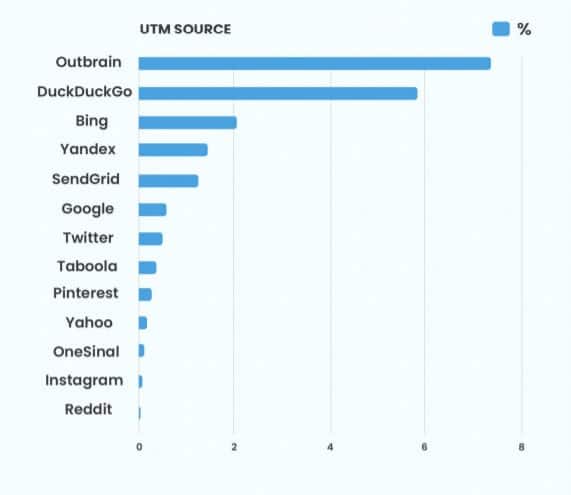
Outbrain leads the way in driving the most invalid traffic to publisher websites in this report. DuckDuckGo is close on its heels in second place with Bing and Yandex in third and fourth positions.
Block all Bad Clicks with this Solution
Looking to bust and block invalid traffic on your website? Look no further than the two-time award winning solution Traffic Cop. This cutting-edge solution is designed to detect and prevent fake traffic, helping you to optimize your website’s performance and protect your revenue.
Traffic Cop uses advanced algorithms and machine learning to identify and filter invalid traffic, including bots, click fraud, and other forms of fraudulent activity. With real-time monitoring and alerts, you can stay on top of suspicious activity and take action to protect your website and your revenue.
But that’s not all. Traffic Cop also offers a range of features to help you optimize your website’s traffic and boost your revenue, including ad optimization, traffic segmentation, and more. With detailed reporting and analytics, you can track your website’s performance and make data-driven decisions to improve your results.
Whether you’re a publisher, advertiser, or agency, Traffic Cop is the ultimate solution for killing IVT online.
So why wait? Put an end to fake traffic for good by signing up for Traffic Cop today!
source https://www.monetizemore.com/blog/fake-traffic/

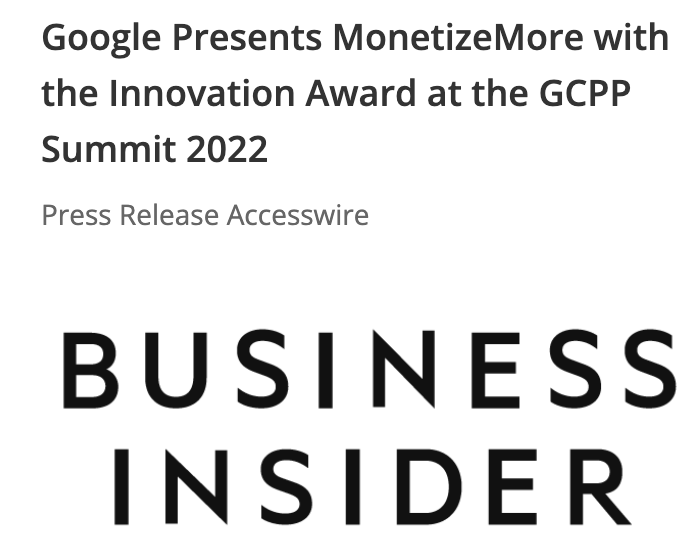


0 Comments